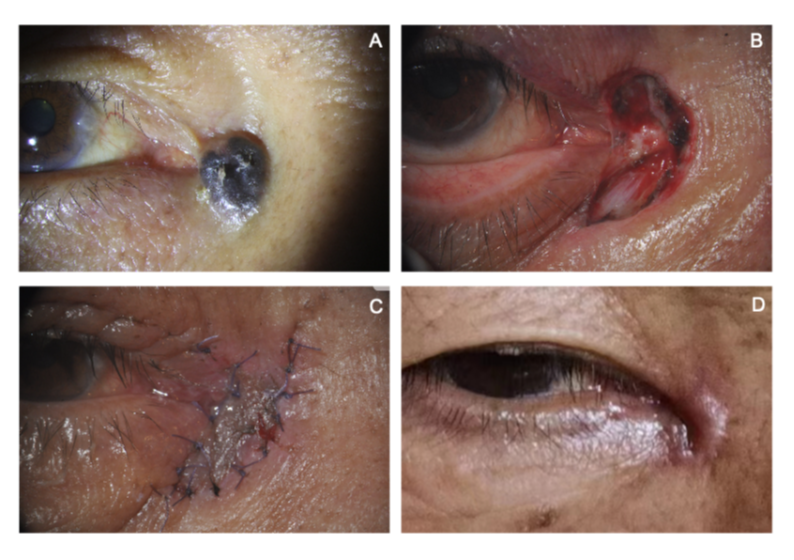1、Cook BE Jr, Bartley GB. Epidemiologic characteristics and clinical course of patients with malignant eyelid tumors in an incidence cohort in Olmsted County, Minnesota[J]. Ophthalmology, 1999, 106(4): 746-750. DOI:10.1016/S0161-6420(99)90161-6.Cook BE Jr, Bartley GB. Epidemiologic characteristics and clinical course of patients with malignant eyelid tumors in an incidence cohort in Olmsted County, Minnesota[J]. Ophthalmology, 1999, 106(4): 746-750. DOI:10.1016/S0161-6420(99)90161-6.
2、Rigel DS, Friedman RJ, Kopf AW. Lifetime risk for development of skin cancer in the U.S. population: current estimate is now 1 in 5[J]. J Am Acad Dermatol, 1996, 35(6): 1012-1013. DOI:10.1016/s0190-9622(96)90139-5.Rigel DS, Friedman RJ, Kopf AW. Lifetime risk for development of skin cancer in the U.S. population: current estimate is now 1 in 5[J]. J Am Acad Dermatol, 1996, 35(6): 1012-1013. DOI:10.1016/s0190-9622(96)90139-5.
3、Oh CC, Jin A, Koh WP. Trends of cutaneous basal cell carcinoma, squamous cell carcinoma, and melanoma among the Chinese, Malays, and Indians in Singapore from 1968-2016[J]. JAAD Int, 2021, 4: 39-45. DOI:10.1016/j.jdin.2021.05.006.Oh CC, Jin A, Koh WP. Trends of cutaneous basal cell carcinoma, squamous cell carcinoma, and melanoma among the Chinese, Malays, and Indians in Singapore from 1968-2016[J]. JAAD Int, 2021, 4: 39-45. DOI:10.1016/j.jdin.2021.05.006.
4、de Vries E, Louwman M, Bastiaens M, et al. Rapid and continuous increases in incidence rates of basal cell carcinoma in the southeast Netherlands since 1973[J]. J Investig Dermatol, 2004, 123(4): 634-638. DOI:10.1111/j.0022-202X.2004.23306.x.de Vries E, Louwman M, Bastiaens M, et al. Rapid and continuous increases in incidence rates of basal cell carcinoma in the southeast Netherlands since 1973[J]. J Investig Dermatol, 2004, 123(4): 634-638. DOI:10.1111/j.0022-202X.2004.23306.x.
5、Flohil SC, Seubring I, van Rossum MM, et al. Trends in basal cell carcinoma incidence rates: a 37-year Dutch observational study[J]. J Investig Dermatol, 2013, 133(4): 913-918. DOI:10.1038/jid.2012.431.Flohil SC, Seubring I, van Rossum MM, et al. Trends in basal cell carcinoma incidence rates: a 37-year Dutch observational study[J]. J Investig Dermatol, 2013, 133(4): 913-918. DOI:10.1038/jid.2012.431.
6、Peris K, Fargnoli MC, Kaufmann R, et al. European consensus-based interdisciplinary guideline for diagnosis and treatment of basal cell carcinoma: update 2023[J]. Eur J Cancer, 2023, 192: 113254. DOI:10.1016/j.ejca.2023.113254.Peris K, Fargnoli MC, Kaufmann R, et al. European consensus-based interdisciplinary guideline for diagnosis and treatment of basal cell carcinoma: update 2023[J]. Eur J Cancer, 2023, 192: 113254. DOI:10.1016/j.ejca.2023.113254.
7、Scrivener Y, Grosshans E, Cribier B. Variations of basal cell carcinomas according to gender, age, location and histopathological subtype[J]. Br J Dermatol, 2002, 147(1): 41-47. DOI:10.1046/j.1365-2133.2002.04804.x.Scrivener Y, Grosshans E, Cribier B. Variations of basal cell carcinomas according to gender, age, location and histopathological subtype[J]. Br J Dermatol, 2002, 147(1): 41-47. DOI:10.1046/j.1365-2133.2002.04804.x.
8、Grob JJ, Gaudy-Marqueste C, Guminski A, et al. Position statement on classification of basal cell carcinomas. Part 2: EADO proposal for new operational staging system adapted to basal cell carcinomas[J]. Acad Dermatol Venereol, 2021, 35(11): 2149-2153. DOI:10.1111/jdv.17467. Grob JJ, Gaudy-Marqueste C, Guminski A, et al. Position statement on classification of basal cell carcinomas. Part 2: EADO proposal for new operational staging system adapted to basal cell carcinomas[J]. Acad Dermatol Venereol, 2021, 35(11): 2149-2153. DOI:10.1111/jdv.17467.
9、Bichakjian CK, Olencki T, Aasi SZ, et al. Basal cell skin cancer, version 1.2016, NCCN clinical practice guidelines in oncology[J]. J Natl Compr Canc Netw, 2016, 14(5): 574-597. DOI:10.6004/jnccn.2016.0065.Bichakjian CK, Olencki T, Aasi SZ, et al. Basal cell skin cancer, version 1.2016, NCCN clinical practice guidelines in oncology[J]. J Natl Compr Canc Netw, 2016, 14(5): 574-597. DOI:10.6004/jnccn.2016.0065.
10、Grob JJ, Guminski A, Malvehy J, et al. Position statement on classification of basal cell carcinomas. Part 1: unsupervised clustering of experts as a way to build an operational classification of advanced basal cell carcinoma based on pattern recognition[J]. J Eur Acad Dermatol Venereol, 2021, 35(10): 1949-1956. DOI:10.1111/jdv.17466.Grob JJ, Guminski A, Malvehy J, et al. Position statement on classification of basal cell carcinomas. Part 1: unsupervised clustering of experts as a way to build an operational classification of advanced basal cell carcinoma based on pattern recognition[J]. J Eur Acad Dermatol Venereol, 2021, 35(10): 1949-1956. DOI:10.1111/jdv.17466.
11、Micali G, Lacarrubba F. Dermatoscopy: instrumental update[J]. Dermatol Clin, 2018, 36(4): 345-348. DOI:10.1016/j.det.2018.05.001. Micali G, Lacarrubba F. Dermatoscopy: instrumental update[J]. Dermatol Clin, 2018, 36(4): 345-348. DOI:10.1016/j.det.2018.05.001.
12、Menzies SW, Westerhoff K, Rabinovitz H, et al. Surface microscopy of pigmented basal cell carcinoma[J]. Arch Dermatol, 2000, 136(8): 1012-1016. DOI:10.1001/archderm.136.8.1012.Menzies SW, Westerhoff K, Rabinovitz H, et al. Surface microscopy of pigmented basal cell carcinoma[J]. Arch Dermatol, 2000, 136(8): 1012-1016. DOI:10.1001/archderm.136.8.1012.
13、Altamura D, Menzies SW, Argenziano G, et al. Dermatoscopy of basal cell carcinoma: Morphologic variability of global and local features and accuracy of diagnosis[J]. J Am Acad Dermatol, 2010, 62(1): 67-75. DOI:10.1016/j.jaad.2009.05.035. Altamura D, Menzies SW, Argenziano G, et al. Dermatoscopy of basal cell carcinoma: Morphologic variability of global and local features and accuracy of diagnosis[J]. J Am Acad Dermatol, 2010, 62(1): 67-75. DOI:10.1016/j.jaad.2009.05.035.
14、Rosendahl C, Tschandl P, Cameron A, et al. Diagnostic accuracy of dermatoscopy for melanocytic and nonmelanocytic pigmented lesions[J]. J Am Acad Dermatol, 2011, 64(6): 1068-1073. DOI:10.1016/j.jaad.2010.03.039. Rosendahl C, Tschandl P, Cameron A, et al. Diagnostic accuracy of dermatoscopy for melanocytic and nonmelanocytic pigmented lesions[J]. J Am Acad Dermatol, 2011, 64(6): 1068-1073. DOI:10.1016/j.jaad.2010.03.039.
15、Pan Y, Chamberlain AJ, Bailey M, et al. Dermatoscopy aids in the diagnosis of the solitary red scaly patch or plaque-features distinguishing superficial basal cell carcinoma, intraepidermal carcinoma, and psoriasis[J]. J Am Acad Dermatol, 2008, 59(2): 268-274. DOI:10.1016/j.jaad.2008.05.013. Pan Y, Chamberlain AJ, Bailey M, et al. Dermatoscopy aids in the diagnosis of the solitary red scaly patch or plaque-features distinguishing superficial basal cell carcinoma, intraepidermal carcinoma, and psoriasis[J]. J Am Acad Dermatol, 2008, 59(2): 268-274. DOI:10.1016/j.jaad.2008.05.013.
16、Micantonio T, Gulia A, Altobelli E, et al. Vascular patterns in basal cell carcinoma[J]. Acad Dermatol Venereol, 2011, 25(3): 358-361. DOI:10.1111/j.1468-3083.2010.03734.x. Micantonio T, Gulia A, Altobelli E, et al. Vascular patterns in basal cell carcinoma[J]. Acad Dermatol Venereol, 2011, 25(3): 358-361. DOI:10.1111/j.1468-3083.2010.03734.x.
17、Que SKT, Fraga-Braghiroli N, Grant-Kels JM, et al. Through the looking glass: Basics and principles of reflectance confocal microscopy[J]. J Am Acad Dermatol, 2015, 73(2): 276-284. DOI:10.1016/j.jaad.2015.04.047. Que SKT, Fraga-Braghiroli N, Grant-Kels JM, et al. Through the looking glass: Basics and principles of reflectance confocal microscopy[J]. J Am Acad Dermatol, 2015, 73(2): 276-284. DOI:10.1016/j.jaad.2015.04.047.
18、Cinotti E, Perrot JL, Campolmi N, et al. The role of in vivo confocal microscopy in the diagnosis of eyelid margin tumors: 47 cases[J]. J Am Acad Dermatol, 2014, 71(5): 912-918.e2. DOI:10.1016/j.jaad.2014.05.060. Cinotti E, Perrot JL, Campolmi N, et al. The role of in vivo confocal microscopy in the diagnosis of eyelid margin tumors: 47 cases[J]. J Am Acad Dermatol, 2014, 71(5): 912-918.e2. DOI:10.1016/j.jaad.2014.05.060.
19、González S, Tannous Z. Real-time, in vivo confocal reflectance microscopy of basal cell carcinoma[J]. J Am Acad Dermatol, 2002, 47(6): 869-874. DOI:10.1067/mjd.2002.124690.González S, Tannous Z. Real-time, in vivo confocal reflectance microscopy of basal cell carcinoma[J]. J Am Acad Dermatol, 2002, 47(6): 869-874. DOI:10.1067/mjd.2002.124690.
20、Alarcon I, Carrera C, Turegano P, et al. Basal cell carcinoma with spontaneous regression: added value of reflectance confocal microscopy when the dermoscopic diagnosis is uncertain[J]. J Am Acad Dermatol, 2014, 71(1): e7-9. DOI:10.1016/j.jaad.2014.01.877. Alarcon I, Carrera C, Turegano P, et al. Basal cell carcinoma with spontaneous regression: added value of reflectance confocal microscopy when the dermoscopic diagnosis is uncertain[J]. J Am Acad Dermatol, 2014, 71(1): e7-9. DOI:10.1016/j.jaad.2014.01.877.
21、Ulrich M, von Braunmuehl T, Kurzen H, et al. The sensitivity and specificity of optical coherence tomography for the assisted diagnosis of nonpigmented basal cell carcinoma: an observational study[J]. Br J Dermatol, 2015, 173(2): 428-435. DOI:10.1111/bjd.13853. Ulrich M, von Braunmuehl T, Kurzen H, et al. The sensitivity and specificity of optical coherence tomography for the assisted diagnosis of nonpigmented basal cell carcinoma: an observational study[J]. Br J Dermatol, 2015, 173(2): 428-435. DOI:10.1111/bjd.13853.
22、Bergeron S, Arthurs B, Sanft DM, et al. Optical coherence tomography of peri-ocular skin cancers: an optical biopsy[J]. Ocul Oncol Pathol, 2021, 7(2): 149-158. DOI:10.1159/000511188. Bergeron S, Arthurs B, Sanft DM, et al. Optical coherence tomography of peri-ocular skin cancers: an optical biopsy[J]. Ocul Oncol Pathol, 2021, 7(2): 149-158. DOI:10.1159/000511188.
23、Cheng HM, Lo S, Scolyer R, et al. Accuracy of optical coherence tomography for the diagnosis of superficial basal cell carcinoma: a prospective, consecutive, cohort study of 168 cases[J]. Br J Dermatol, 2016, 175(6): 1290-1300. DOI:10.1111/bjd.14714. Cheng HM, Lo S, Scolyer R, et al. Accuracy of optical coherence tomography for the diagnosis of superficial basal cell carcinoma: a prospective, consecutive, cohort study of 168 cases[J]. Br J Dermatol, 2016, 175(6): 1290-1300. DOI:10.1111/bjd.14714.
24、McKay KM, Sambrano BL, Fox PS, et al. Thickness of superficial basal cell carcinoma (sBCC) predicts imiquimod efficacy: a proposal for a thickness-based definition of sBCC[J]. Br J Dermatol, 2013, 169(3): 549-554. DOI:10.1111/bjd.12402. McKay KM, Sambrano BL, Fox PS, et al. Thickness of superficial basal cell carcinoma (sBCC) predicts imiquimod efficacy: a proposal for a thickness-based definition of sBCC[J]. Br J Dermatol, 2013, 169(3): 549-554. DOI:10.1111/bjd.12402.
25、Tanese K. Diagnosis and management of basal cell carcinoma[J]. Curr Treat Options Oncol, 2019, 20(2): 13. DOI:10.1007/s11864-019-0610-0. Tanese K. Diagnosis and management of basal cell carcinoma[J]. Curr Treat Options Oncol, 2019, 20(2): 13. DOI:10.1007/s11864-019-0610-0.
26、Zhou Y, Tao L, Qiu J, et al. Tumor biomarkers for diagnosis, prognosis and targeted therapy[J]. Signal Transduct Target Ther, 2024, 9(1): 132. DOI:10.1038/s41392-024-01823-2. Zhou Y, Tao L, Qiu J, et al. Tumor biomarkers for diagnosis, prognosis and targeted therapy[J]. Signal Transduct Target Ther, 2024, 9(1): 132. DOI:10.1038/s41392-024-01823-2.
27、Jolehar M, Anghaei S, Kamyab-Hesari K, et al. New diagnostic markers in basal cell carcinoma[J]. J Oral Maxillofac Pathol, 2020, 24(1): 99. DOI:10.4103/jomfp.jomfp_199_19. Jolehar M, Anghaei S, Kamyab-Hesari K, et al. New diagnostic markers in basal cell carcinoma[J]. J Oral Maxillofac Pathol, 2020, 24(1): 99. DOI:10.4103/jomfp.jomfp_199_19.
28、Louie L, Wise J, Berl A, et al. High-throughput lipidomic profiles sampled with electroporation-based biopsy differentiate healthy skin, cutaneous squamous cell carcinoma, and basal cell carcinoma[J]. Skin Res Technol, 2024, 30(5): e13706. DOI:10.1111/srt.13706.Louie L, Wise J, Berl A, et al. High-throughput lipidomic profiles sampled with electroporation-based biopsy differentiate healthy skin, cutaneous squamous cell carcinoma, and basal cell carcinoma[J]. Skin Res Technol, 2024, 30(5): e13706. DOI:10.1111/srt.13706.
29、Huang J, Schaefer J, Wang Y, et al. Metabolic signature of eyelid basal cell carcinoma[J]. Exp Eye Res, 2020, 198: 108140. DOI:10.1016/j.exer.2020.108140.Huang J, Schaefer J, Wang Y, et al. Metabolic signature of eyelid basal cell carcinoma[J]. Exp Eye Res, 2020, 198: 108140. DOI:10.1016/j.exer.2020.108140.
30、Huang Y, He C, Hu Q, et al. Metabolic atlas of human eyelid infiltrative basal cell carcinoma[J]. Invest Ophthalmol Vis Sci, 2025, 66(1): 11. DOI:10.1167/iovs.66.1.11. Huang Y, He C, Hu Q, et al. Metabolic atlas of human eyelid infiltrative basal cell carcinoma[J]. Invest Ophthalmol Vis Sci, 2025, 66(1): 11. DOI:10.1167/iovs.66.1.11.
31、Hernandez LE, Mohsin N, Levin N, et al. Basal cell carcinoma: an updated review of pathogenesis and treatment options[J]. Dermatol Ther, 2022, 35(6): e15501. DOI:10.1111/dth.15501. Hernandez LE, Mohsin N, Levin N, et al. Basal cell carcinoma: an updated review of pathogenesis and treatment options[J]. Dermatol Ther, 2022, 35(6): e15501. DOI:10.1111/dth.15501.
32、Gutzmer R, Solomon JA. Hedgehog pathway inhibition for the treatment of basal cell carcinoma[J]. Target Oncol, 2019, 14(3): 253-267. DOI:10.1007/s11523-019-00648-2. Gutzmer R, Solomon JA. Hedgehog pathway inhibition for the treatment of basal cell carcinoma[J]. Target Oncol, 2019, 14(3): 253-267. DOI:10.1007/s11523-019-00648-2.
33、Guo Y, Rokohl AC, Kopecky A, et al. Periocular basal cell carcinoma: current treatment concepts[J]. Ann Eye Sci, 2021, 6: 18. DOI:10.21037/aes-20-100.Guo Y, Rokohl AC, Kopecky A, et al. Periocular basal cell carcinoma: current treatment concepts[J]. Ann Eye Sci, 2021, 6: 18. DOI:10.21037/aes-20-100.
34、Nasr I, McGrath EJ, Harwood CA, et al. British Association of Dermatologists guidelines for the management of adults with basal cell carcinoma 2021[J]. Br J Dermatol, 2021, 185(5): 899-920. DOI:10.1111/bjd.20524. Nasr I, McGrath EJ, Harwood CA, et al. British Association of Dermatologists guidelines for the management of adults with basal cell carcinoma 2021[J]. Br J Dermatol, 2021, 185(5): 899-920. DOI:10.1111/bjd.20524.
35、Nahhas AF, Scarbrough CA, Trotter S. A review of the global guidelines on surgical margins for nonmelanoma skin cancers[J]. J Clin Aesthet Dermatol, 2017, 10(4): 37-46. Nahhas AF, Scarbrough CA, Trotter S. A review of the global guidelines on surgical margins for nonmelanoma skin cancers[J]. J Clin Aesthet Dermatol, 2017, 10(4): 37-46.
36、Lang BM, Balermpas P, Bauer A, et al. S2k guidelines for cutaneous basal cell carcinoma–part 2: treatment, prevention and follow-up[J]. J Deutsche Derma Gesell, 2019, 17(2): 214-230. DOI:10.1111/ddg.13755.Lang BM, Balermpas P, Bauer A, et al. S2k guidelines for cutaneous basal cell carcinoma–part 2: treatment, prevention and follow-up[J]. J Deutsche Derma Gesell, 2019, 17(2): 214-230. DOI:10.1111/ddg.13755.
37、Gulleth Y, Goldberg N, Silverman RP, et al. What is the best surgical margin for a Basal cell carcinoma: a meta-analysis of the literature[J]. Plast Reconstr Surg, 2010, 126(4): 1222-1231. DOI:10.1097/PRS.0b013e3181ea450d.Gulleth Y, Goldberg N, Silverman RP, et al. What is the best surgical margin for a Basal cell carcinoma: a meta-analysis of the literature[J]. Plast Reconstr Surg, 2010, 126(4): 1222-1231. DOI:10.1097/PRS.0b013e3181ea450d.
38、Kuijpers DIM, Thissen MRTM, Neumann MHA. Basal cell carcinoma: treatment options and prognosis, a scientific approach to a common malignancy[J]. Am J Clin Dermatol, 2002, 3(4): 247-259. DOI:10.2165/00128071-200203040-00003.Kuijpers DIM, Thissen MRTM, Neumann MHA. Basal cell carcinoma: treatment options and prognosis, a scientific approach to a common malignancy[J]. Am J Clin Dermatol, 2002, 3(4): 247-259. DOI:10.2165/00128071-200203040-00003.
39、Ito T, Inatomi Y, Nagae K, et al. Narrow-margin excision is a safe, reliable treatment for well-defined, primary pigmented basal cell carcinoma: an analysis of 288 lesions in Japan[J]. J Eur Acad Dermatol Venereol, 2015, 29(9): 1828-1831. DOI:10.1111/jdv.12689. Ito T, Inatomi Y, Nagae K, et al. Narrow-margin excision is a safe, reliable treatment for well-defined, primary pigmented basal cell carcinoma: an analysis of 288 lesions in Japan[J]. J Eur Acad Dermatol Venereol, 2015, 29(9): 1828-1831. DOI:10.1111/jdv.12689.
40、Lin%20SH%2C%20Cheng%20YW%2C%20Yang%20YC%2C%20et%20al.%20Treatment%20of%20pigmented%20basal%20cell%20carcinoma%20with%203%E2%80%89mm%20surgical%20margin%20in%20asians%5BJ%5D.%20Biomed%20Res%20Int%2C%202016%2C%202016%3A%207682917.%20DOI%3A10.1155%2F2016%2F7682917.%20Lin%20SH%2C%20Cheng%20YW%2C%20Yang%20YC%2C%20et%20al.%20Treatment%20of%20pigmented%20basal%20cell%20carcinoma%20with%203%E2%80%89mm%20surgical%20margin%20in%20asians%5BJ%5D.%20Biomed%20Res%20Int%2C%202016%2C%202016%3A%207682917.%20DOI%3A10.1155%2F2016%2F7682917.%20
41、Kim%20ES%2C%20Yang%20CE%2C%20Chung%20YK.%20Does%20reduction%20of%20the%20oncologic%20safety%20margin%20for%20facial%20basal%20cell%20carcinoma%20result%20in%20higher%20recurrence%20rates%3F%5BJ%5D.%20Arch%20Craniofac%20Surg%2C%202021%2C%2022(3)%3A%20135-140.%20DOI%3A10.7181%2Facfs.2021.00206.Kim%20ES%2C%20Yang%20CE%2C%20Chung%20YK.%20Does%20reduction%20of%20the%20oncologic%20safety%20margin%20for%20facial%20basal%20cell%20carcinoma%20result%20in%20higher%20recurrence%20rates%3F%5BJ%5D.%20Arch%20Craniofac%20Surg%2C%202021%2C%2022(3)%3A%20135-140.%20DOI%3A10.7181%2Facfs.2021.00206.
42、Que SKT. Research techniques made simple: noninvasive imaging technologies for the delineation of basal cell carcinomas[J]. J Invest Dermatol, 2016, 136(4): e33-e38. DOI:10.1016/j.jid.2016.02.012.Que SKT. Research techniques made simple: noninvasive imaging technologies for the delineation of basal cell carcinomas[J]. J Invest Dermatol, 2016, 136(4): e33-e38. DOI:10.1016/j.jid.2016.02.012.
43、Leibovitch I, McNab A, Sullivan T, et al. Orbital invasion by periocular basal cell carcinoma[J]. Ophthalmology, 2005, 112(4): 717-723. DOI:10.1016/j.ophtha.2004.11.036. Leibovitch I, McNab A, Sullivan T, et al. Orbital invasion by periocular basal cell carcinoma[J]. Ophthalmology, 2005, 112(4): 717-723. DOI:10.1016/j.ophtha.2004.11.036.
44、Sun MT, Wu A, Figueira E, et al. Management of periorbital basal cell carcinoma with orbital invasion[J]. Future Oncol, 2015, 11(22): 3003-3010. DOI:10.2217/fon.15.190. Sun MT, Wu A, Figueira E, et al. Management of periorbital basal cell carcinoma with orbital invasion[J]. Future Oncol, 2015, 11(22): 3003-3010. DOI:10.2217/fon.15.190.
45、Rio E, Bardet E, Ferron C, et al. Interstitial brachytherapy of periorificial skin carcinomas of the face: a retrospective study of 97 cases[J]. Int J Radiat Oncol, 2005, 63(3): 753-757. DOI:10.1016/j.ijrobp.2005.03.027. Rio E, Bardet E, Ferron C, et al. Interstitial brachytherapy of periorificial skin carcinomas of the face: a retrospective study of 97 cases[J]. Int J Radiat Oncol, 2005, 63(3): 753-757. DOI:10.1016/j.ijrobp.2005.03.027.
46、Dirix L, Rutten A. Vismodegib: a promising drug in the treatment of basal cell carcinomas[J]. Future Oncol, 2012, 8(8): 915-928. DOI:10.2217/fon.12.82. Dirix L, Rutten A. Vismodegib: a promising drug in the treatment of basal cell carcinomas[J]. Future Oncol, 2012, 8(8): 915-928. DOI:10.2217/fon.12.82.
47、Yin VT, Pfeiffer ML, Esmaeli B. Targeted therapy for orbital and periocular basal cell carcinoma and squamous cell carcinoma[J]. Ophthalmic Plast Reconstr Surg, 2013, 29(2): 87-92. DOI:10.1097/IOP.0b013e3182831bf3. Yin VT, Pfeiffer ML, Esmaeli B. Targeted therapy for orbital and periocular basal cell carcinoma and squamous cell carcinoma[J]. Ophthalmic Plast Reconstr Surg, 2013, 29(2): 87-92. DOI:10.1097/IOP.0b013e3182831bf3.
48、Lear JT, Migden MR, Lewis KD, et al. Long-term efficacy and safety of sonidegib in patients with locally advanced and metastatic basal cell carcinoma: 30-month analysis of the randomized phase 2 BOLT study[J]. J Eur Acad Dermatol Venereol, 2018, 32(3): 372-381. DOI:10.1111/jdv.14542.Lear JT, Migden MR, Lewis KD, et al. Long-term efficacy and safety of sonidegib in patients with locally advanced and metastatic basal cell carcinoma: 30-month analysis of the randomized phase 2 BOLT study[J]. J Eur Acad Dermatol Venereol, 2018, 32(3): 372-381. DOI:10.1111/jdv.14542.
49、Danial C, Sarin KY, Oro AE, et al. An investigator-initiated open-label trial of sonidegib in advanced basal cell carcinoma patients resistant to vismodegib[J]. Clin Cancer Res, 2016, 22(6): 1325-1329. DOI:10.1158/1078-0432.ccr-15-1588.Danial C, Sarin KY, Oro AE, et al. An investigator-initiated open-label trial of sonidegib in advanced basal cell carcinoma patients resistant to vismodegib[J]. Clin Cancer Res, 2016, 22(6): 1325-1329. DOI:10.1158/1078-0432.ccr-15-1588.
50、Dong X, Wang C, Chen Z, et al. Overcoming the resistance mechanisms of Smoothened inhibitors[J]. Drug Discov Today, 2018, 23(3): 704-710. DOI:10.1016/j.drudis.2018.01.012.Dong X, Wang C, Chen Z, et al. Overcoming the resistance mechanisms of Smoothened inhibitors[J]. Drug Discov Today, 2018, 23(3): 704-710. DOI:10.1016/j.drudis.2018.01.012.
51、Bendell%20J%2C%20Andre%20V%2C%20Ho%20A%2C%20et%20al.%20Phase%20I%20study%20of%20LY2940680%2C%20a%20smo%20antagonist%2C%20in%20patients%20with%20advanced%20cancer%20including%20treatment-Na%C3%AFve%20and%20previously%20treated%20basal%20cell%20carcinoma%5BJ%5D.%20Clin%20Cancer%20Res%2C%202018%2C%2024(9)%3A%202082-2091.%20DOI%3A10.1158%2F1078-0432.ccr-17-0723.Bendell%20J%2C%20Andre%20V%2C%20Ho%20A%2C%20et%20al.%20Phase%20I%20study%20of%20LY2940680%2C%20a%20smo%20antagonist%2C%20in%20patients%20with%20advanced%20cancer%20including%20treatment-Na%C3%AFve%20and%20previously%20treated%20basal%20cell%20carcinoma%5BJ%5D.%20Clin%20Cancer%20Res%2C%202018%2C%2024(9)%3A%202082-2091.%20DOI%3A10.1158%2F1078-0432.ccr-17-0723.
52、Sabbatino F, Marra A, Liguori L, et al. Resistance to anti-PD-1-based immunotherapy in basal cell carcinoma: a case report and review of the literature[J]. J Immunother Cancer, 2018, 6(1): 126. DOI:10.1186/s40425-018-0439-2.Sabbatino F, Marra A, Liguori L, et al. Resistance to anti-PD-1-based immunotherapy in basal cell carcinoma: a case report and review of the literature[J]. J Immunother Cancer, 2018, 6(1): 126. DOI:10.1186/s40425-018-0439-2.
53、Lipson EJ, Lilo MT, Ogurtsova A, et al. Basal cell carcinoma: PD-L1/PD-1 checkpoint expression and tumor regression after PD-1 blockade[J]. J Immunother Cancer, 2017, 5: 23. DOI:10.1186/s40425-017-0228-3.Lipson EJ, Lilo MT, Ogurtsova A, et al. Basal cell carcinoma: PD-L1/PD-1 checkpoint expression and tumor regression after PD-1 blockade[J]. J Immunother Cancer, 2017, 5: 23. DOI:10.1186/s40425-017-0228-3.
54、Lewis KD, Peris K, Sekulic A, et al. Final analysis of phase II results with cemiplimab in metastatic basal cell carcinoma after hedgehog pathway inhibitors[J]. Ann Oncol, 2024, 35(2): 221-228. DOI:10.1016/j.annonc.2023.10.123.Lewis KD, Peris K, Sekulic A, et al. Final analysis of phase II results with cemiplimab in metastatic basal cell carcinoma after hedgehog pathway inhibitors[J]. Ann Oncol, 2024, 35(2): 221-228. DOI:10.1016/j.annonc.2023.10.123.
55、Erikson K, Brosig A, Zimbelmann MW, et al. Alternative treatment options for periocular basal cell carcinoma: a narrative review[J]. Front Oral Maxillofac Med, 2022, 4: 25. DOI:10.21037/fomm-21-19.Erikson K, Brosig A, Zimbelmann MW, et al. Alternative treatment options for periocular basal cell carcinoma: a narrative review[J]. Front Oral Maxillofac Med, 2022, 4: 25. DOI:10.21037/fomm-21-19.
56、Kavoussi H, Ebrahimi A. Treatment and cosmetic outcome of superpulsed CO2 laser for basal cell carcinoma[J]. Acta Dermatovenerol Alp Pannonica Adriat, 2013, 22(3): 57-61.Kavoussi H, Ebrahimi A. Treatment and cosmetic outcome of superpulsed CO2 laser for basal cell carcinoma[J]. Acta Dermatovenerol Alp Pannonica Adriat, 2013, 22(3): 57-61.
57、Tuppurainen K. Cryotherapy for eyelid and periocular basal cell carcinomas: outcome in 166 cases over an 8-year period[J]. Graefe’s Arch Clin Exp Ophthalmol, 1995, 233(4): 205-208. DOI:10.1007/bf00183593.Tuppurainen K. Cryotherapy for eyelid and periocular basal cell carcinomas: outcome in 166 cases over an 8-year period[J]. Graefe’s Arch Clin Exp Ophthalmol, 1995, 233(4): 205-208. DOI:10.1007/bf00183593.




